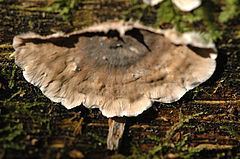Kingdom Fungi Class Agaricomycetes Family Gloeophyllaceae | Division Basidiomycota Rank Genus | |
 | ||
Similar Gloeophyllales, Heliocybe, Gloeophyllaceae, Sistotremastrum, Tubulicrinis | ||
Collybia veluticeps fungi kingdom
Veluticeps is a small genus of wood-rot fungi characterized by the production of resupinate to bracket shaped, perennial, tough, brown fruitbodies, that blacken when KOH solution is applied, and with a smooth to warted or cracked fertile undersurface. They cause a brown rot of wood.[1] Cystidia in the hymenium are characteristically mostly in fascicles. The genus may be monotypic if Columnocystis is excluded. Phylogenetically, the type species, V. berkeleyi, groups with several other brown rot genera such as Neolentinus, Heliocybe, and Gloeophyllum.
Contents
Veluticeps fungi kingdom
Etymology
The name Veltuiceps was an elevation of the former species epithet "veluticeps" for the type species which was renamed, V. berkeleyi. Tautonyms, such as "Veluticeps veluticeps" would be illegitimate under the International Code of Botanical Nomenclature. The name combines velutum or velutinus, meaning velvelty with -ceps meaning head, combined to mean velvety head, a reference to its velvety hymenium, rather than the actual upper surface (when it actually has a reflexed or bracket shape, which it does not always have).
